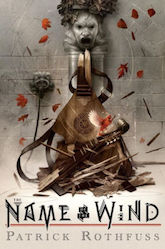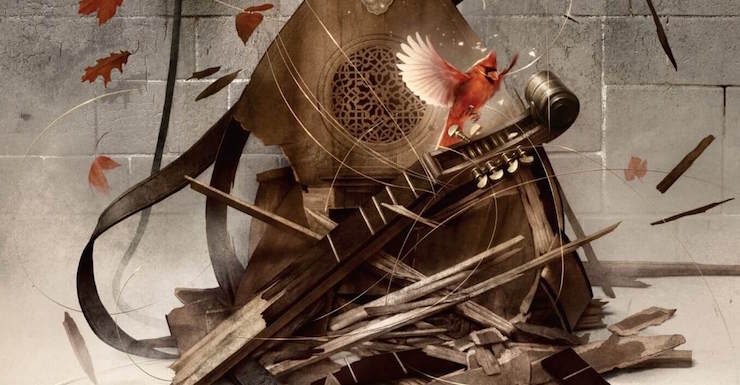I first read The Name of the Wind a few years after it had come out, and I inhaled it. Afterward, it stayed inside my heart, lighting me from within like a candle flame. It was intricate and beautiful and complex, a tale of two different times, and two very different men: the hero of our story, young and full of confidence, and the person he became in the wake of tragedy. Then, I reread it, recognizing and reliving everything again—and yet, I saw more. I saw that the tales told are the same tale, spun out over and over again in different ways. And it blew me away, this recognition of the way stories shift and change and warp over time. And then I read it a third time, and I saw the details of histories underlying the bones of the modern tale, and the rhymes in the words, and the hints of realities hovering beneath this one.
Every time I read The Name of the Wind, I seem to discover more and more. Patrick Rothfuss has made a story that is rich, complex, and stands the test of time. The Name of the Wind is a 21st century fantasy classic for this reason, but there are so many other reasons to revisit this world again and again. Here are just a few:
1: Kvothe/Kote
Buy the Book


One of the main draws to this novel, and the series as a whole, is that Kvothe is the key that holds the story together. Brilliant but proud, spirited but sometimes obnoxious, heroic but lacking in wisdom, Kvothe in his time as a young man represents the hero’s journey, from ignorance and safety to knowledge, danger, and courage. He may strike some as a “perfect” character who can do no wrong, but don’t be mistaken. He has his flaws, but they stem largely from his arrogance, inexperience, and youth, and we see that no better than in the figure of Kote in his inn, hiding from the world in the sections of the story that frame the narratives of his younger days. All that youthful hubris and quick-tempered rage have been swept away to reveal a quiet, deeply damaged individual, waiting to die. How we get there, and how the youth became this broken man, is one of the series’ most intriguing mysteries, drawing readers ever deeper into Kote’s story.
2: The Setting
Rothfuss knows what he is doing when it comes to worldbuilding, and Temerant reads in many ways like a rediscovered world of old. It feels real, and lived in, with intricate systems of currency, government, language, magic, nobility, myth, and more. While we only see glimpse the small corners that Rothfuss introduces us to through Kvothe, the sheer amount of history, the sense of scope, and hints strewn like breadcrumbs throughout the narrative ensure that readers are constantly learning about and thinking about the various nations, cultures, and histories interwoven in this world—and keeps us on the alert for new facts and clues.
3: The Frame Story
One of the most compelling parts of The Name of the Wind is coming to know Kvothe through his time as the quiet innkeeper Kote…and then being transported by the narrative back to his youth and seeing who this withdrawn, bittersweet, broken man used to be. Rothfuss doesn’t introduce us to the legend until page sixty or so, and by pivoting so quickly, he throws the reader off guard, and introduces us to the central mystery of this whole series: Who is Kvothe? And what happened to make him the way he is now? These mysteries are the driving heart of the novel, and the slow unfurling of their truths have tantalized readers every step of the way. We know that something terrible has happened; we just don’t know what it is…at least, not yet. Rothfuss’ clever shifts between the narratives cleverly contrast the brilliant young man our protagonist used to be with the broken man he’s become, with each side of the story lending depth and mystery to the other. Not only that, but the frame story introduces us to the curious Chronicler, who first draws out Kvothe’s story, as well as the Fae prince, Bast—Kote’s student and friend (and a more powerful, sly, and trickier figure than one might expect). We gradually come to notice the strings Bast is pulling through the frame, as well as Chronicler’s response, both of which continue to inform Kvothe’s own story.
4: The Magic
According to Rothfuss, there are eight individual magic systems in the world of Temerant (though we’ve actually only seen six so far), and like his history, religion, lore, and more, Rothfuss imbues each of them with specific, lovely details. He has his cake, and he gets to eat it, too, as Temerant is filled with modern, specific, science-based magics, such as sympathy, sygaldry, alchemy, etc., while also a world still very much in touch with its deeper, more mystical powers: Naming, Glammourie, and Grammarie. While we’ve only seen the Fae wield the latter, humans can also utilize Naming, should they have the knack, talent, or luck to stumble into it.
5: The Intersection of Fantasy and Reality
Rothfuss went through painstaking work to make his world feel familiar, using language and detail to create the sense of real places populated by relatable, vividly rendered people. From the deep roots of the Atur Empire to the rising prominence of Caeldish moneylenders, from the sword-bright histories of the Adem and their Lethani, to the intricacies of Vintas and the courts within, Temerant is a world that spills off the page like vibrant ink, and while Rothfuss spins his tale of Kvothe, could easily bleed onto other pages and swirl into life of its own. He combines the lived-in sweat, blood, and anxieties of real-life experience and grafts it seamlessly onto a world of magic, dragons, faeries, and intrigue.
6: The Mysteries
Where do we even begin here? While some of these are borne from The Wise Man’s Fear, The Name of the Wind sports enough of its own mysteries to last several graduate level studies. What really happened to Kvothe, and what did he do to end up where he is? Did he really kill a king? Did he really kill an angel? What is the truth behind the Chandrian, and what is the importance of Arliden’s song? Who are the Sithe? What’s behind the door in the library? Who is Mr. Ash? What is Denna’s deal? What exactly was the Creation War? Just… yeah. Lot of questions. But! We’ll learn the answers, someday.
7: The Language
If you’re looking for simple, elegant, beautiful language, go no further than The Name of the Wind. Every time I read it, a new line sticks out to me. But you can tell Rothfuss has a background in poetry, because the way he utilizes language throughout the novel is expert level, the kind of strong, poetic writing that you don’t even notice for how it slides across the page. Reading this language is a pleasure akin to savoring a mug of hot tea, or soaking in a bath, or smelling spring rain as it hits the grass.
8: The Cast of Characters
The Name of the Wind works because Kvothe is such an interesting narrator, and Rothfuss constantly keeps you off guard as to his truths and intent. But this world wouldn’t be as fascinating if it was just him soaking up the spotlight. Aside from Kvothe, we meet the lovely and incomprehensible Denna, who steals his heart, and possibly much more. We have Bast, Prince of the Fae, willing to bend and break those in his way, to do whatever he has to to bring his teacher back from the brink of despair. We have Kilvin and Wil and Simmon and Auri and Stanchion and Deoch and Fela and Mola and Elodin and Devi, and yes, even Ambrose, characters who truly bring the University to life. And then there are Haliax and Selitos and Cinder and Lanre and Lyra and Tehlu and Encanis and all the other figures of myth and legend. The Name of the Wind may be Kvothe’s tale, but the stories of many others are caught up in the wheel of his, and as that wheel turns, so do these many intertwined lives and fates.
9: The Power and Importance of Stories
There is a story of a city in The Name of the Wind, a city that rises and falls through time. It is one story, with one truth at its heart. But Rothfuss tells that story in four or five different ways throughout the novel, and it always impresses me, this detail. That stories change in times and places, and among different peoples. The novel is full of little details like this, and Rothfuss doesn’t shy from this. Stories enrich us, fulfill us, teach us, or warn us. They are a lighthouse at sea, drawing us to safety. They are a candle in the night, gifting us hope, a soft warding from the beings who can stalk the night. Stories are threaded through the entirety of The Name of the Wind, and while their purpose can be myriad, their power is never scoffed at or dismissed. Stories, like names, have power. We can never forget that.
10: Patrick Rothfuss
I think another reason The Name of the Wind resonates is because of the author himself. Rothfuss is a genial, good-natured individual who has done his damnedest to be there for his fans, to talk with them and tell them stories, and share his life and stories of his life, when he wants to. He runs one of the most successful genre-friendly charities that I can think of, and helps get people involved in helping the world. He lifts people up when given the chance. He is a fan who is trying to do good in the world through his writing, and I’m not sure what more can be asked for.
The Name of the Wind is ten years old, but I have no doubt it will continue to age well. The things we love about it are even richer ten years on, with The Wise Man’s Fear and more providing some answers, some clues, to whet out appetite. It is an epic fantasy that delightfully trucks with the tropes of its own genre, only to turn them on their head, re-examine them, figure out why they work, or why they don’t, and play them to a new music entirely.
If you’ve not read it yet, I’d encourage you to do so. The Name of the Wind will be around for some time, and I gladly feel like it won’t be going anywhere anytime soon.
Martin Cahill is a contributor to Tor.com, as well as Book Riot and Strange Horizons. He has fiction forthcoming at Beneath Ceaseless Skies and Fireside Fiction. You can follow his musings on Twitter @McflyCahill90.










